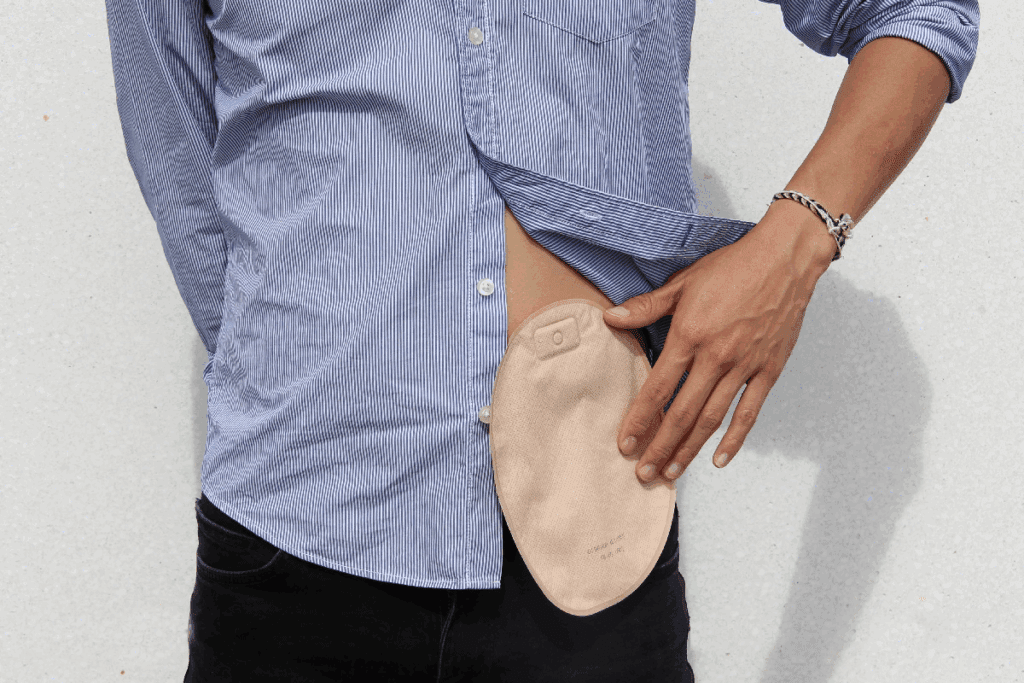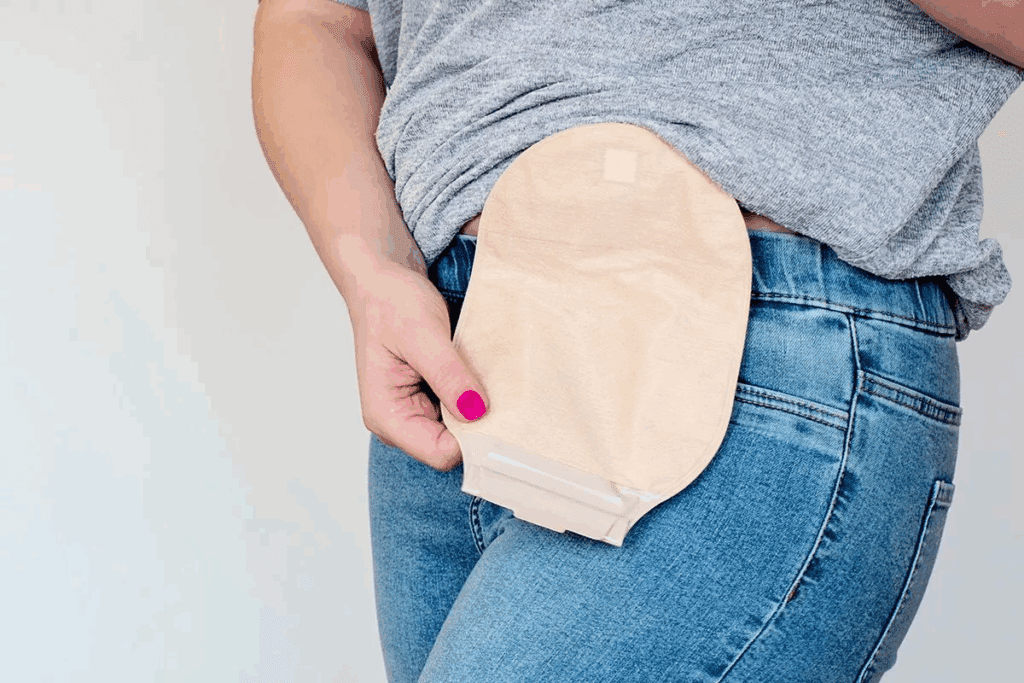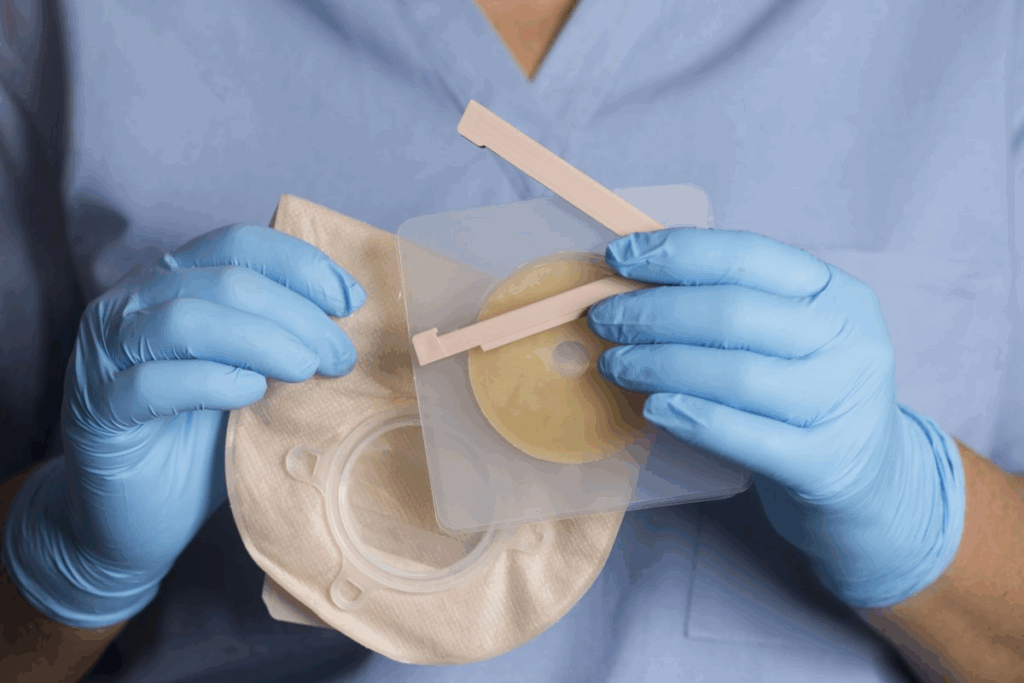Last Updated on November 26, 2025 by Bilal Hasdemir

A colostomy bag, also known as a stoma bag or ostomy bag, is a medical device. It collects waste from the body after a colostomy surgery. This surgery makes an opening, or stoma, between the intestine and the abdominal wall. This allows waste to exit the body.Understand colostomy bag poop collection, how it works, and why it’s needed post-surgery.
People need a colostomy bag for many medical reasons. These include colorectal cancer, inflammatory bowel diseases, trauma, and obstruction. Knowing what a colostomy is and why it’s done is key. It helps patients and caregivers manage the condition well.

Learning about colostomy means looking into its definition, history, and its role in treating colorectal issues. A colostomy is when a hole is made in the colon for stool to pass out without going through the anus. During surgery, a stoma is created in the belly. A part of the colon is brought through this opening and attached to a pouch outside the body.
A colostomy, also known as colestomy, is done for reasons like colorectal cancer, Crohn’s disease, or injury. It involves making a stoma in the belly. This allows stool to go into a colostomy bag.
This procedure is lifesaving. It helps patients manage their condition well, making their lives better despite colorectal diseases or injuries.
Colostomy procedures have come a long way. They were once risky and complex but are now safer thanks to medical advancements. The history of colostomy includes several important steps:
These changes have made colostomy a reliable treatment for many gastrointestinal problems.

A colostomy is a surgery that makes a stoma. This stoma lets stool leave the body. It’s done to help with many colorectal problems.
To make a stoma, surgeons bring part of the colon through the belly. The stoma is then fixed to the skin. This makes a hole for stool to go into a colostomy bag or tube.
The type of colostomy depends on where the stoma is. For example, a stoma in the sigmoid colon is called a sigmoid colostomy.
The stoma’s location depends on the colon part affected. You might have a stoma in the sigmoid, transverse, ascending, or descending colon. Each spot affects how you manage the colostomy and your life quality.
A sigmoid stoma is very common. This is because the sigmoid colon is easy to reach and works well for this purpose.
Knowing where your colostomy is is key. It helps doctors and patients plan better care after surgery.
Many serious health issues can lead to a colostomy. This is a surgery that makes a stoma for diverting fecal matter. It’s needed if injury or a medical condition stops the colon from working right.
Colorectal cancer is a top reason for needing a colostomy. The surgery removes the affected colon part, making a stoma for fecal diversion. Early detection and treatment are key in managing colorectal cancer and possibly avoiding a colostomy.
Inflammatory bowel diseases (IBD) like Crohn’s disease and ulcerative colitis can cause chronic inflammation and damage to the colon. This might require a colostomy. These conditions can be very uncomfortable and lead to serious complications, making surgery necessary in some cases.
Abdominal trauma, bowel obstruction, and congenital conditions are also reasons for a colostomy. The table below lists some key medical conditions that might need a colostomy.
| Medical Condition | Description | Potential Need for Colostomy |
| Colorectal Cancer | Cancer affecting the colon or rectum | Yes, for tumor removal |
| Crohn’s Disease | Chronic inflammatory bowel disease | Yes, in severe cases |
| Ulcerative Colitis | Chronic inflammation of the colon | Yes, if complications arise |
| Trauma | Physical injury to the abdomen | Yes, for repair and diversion |
| Bowel Obstruction | Blockage of the intestine | Yes, to relieve obstruction |
It’s important to understand these causes to manage the condition well. While a colostomy can save lives, treating the underlying condition is key for the best results.
It’s important to know how a colostomy bag works, for those who have had this surgery. A colostomy bag collects and holds waste from the stoma. It makes managing waste easier and keeps things clean.
A colostomy bag has two parts: the pouch for waste and the adhesive flange for skin attachment. The pouch can be drainable or closed-end.
The pouch design keeps waste in, reducing leaks and smells.
The adhesive flange is key for a snug, comfy fit around the stoma.
Here are some important features of a colostomy bag:
Managing a colostomy bag well means knowing its parts and how they work. Together, they offer a safe, clean, and private way to handle waste.
How long a colostomy lasts depends on the colostomy reasons and the goal of the surgery. Whether it’s temporary or permanent depends on the medical condition, surgery extent, and recovery chances.
Temporary colostomies help a part of the colon heal after surgery or injury. They’re common when there’s a lot of damage or disease in a colon section. The surgeon waits for it to heal before reconnecting it.
They’re used in surgeries for colorectal cancer, inflammatory bowel diseases, and abdominal injuries. The main goal is to keep waste away from the healing area. This prevents leaks or infections.
Permanent colostomies are needed when a big part of the colon or rectum is removed. This is often due to advanced colorectal cancer or severe damage to the rectum or anus.
Creating a permanent stoma is necessary for waste disposal. While it requires big lifestyle changes, modern bags and systems help manage it. Patients learn to care for their stoma and colostomy tube to stay clean and avoid problems.
It’s important to understand the difference between temporary and permanent colostomies. This helps patients know what to expect and prepare for the necessary changes. It also sets hopes for possible reversals in temporary cases.
Colostomies are divided by where they are on the colon. Each spot has its own care needs. The type of colostomy depends on where the stoma is made. This affects the surgery and care after it.
A sigmoid colostomy uses the sigmoid colon for the stoma. It’s the most common type. It’s used for lower colon issues like colorectal cancer or diverticulitis. The sigmoid colon is in the lower left abdomen, making it easy to access.
A medical expert says, “Sigmoid colostomy is a lifesaving procedure for severe colorectal conditions.” It shows how important sigmoid colostomies are in colorectal surgery.
Transverse colostomy diverts the middle colon. It’s used for obstructions or trauma in the lower colon. The transverse colon is in the upper abdomen, making it harder to manage but vital for some conditions.
Ascending and descending colostomies are less common. They use the ascending or descending colon for the stoma. Ascending colostomy is for right lower quadrant diseases. Descending colostomy is for when the sigmoid colon can’t be used.
The choice between these depends on the condition, patient health, and surgeon’s choice. Knowing about these colostomies helps healthcare providers and patients manage the condition better.
Colostomy pouching systems come in many types, helping patients manage their condition well. The right system depends on several things. These include what the patient likes, the stoma’s shape, and their lifestyle.
Systems are mainly one-piece or two-piece. One-piece systems combine the pouch and adhesive in one unit. This makes them easy to put on and take off. Two-piece systems let you separate the pouch from the adhesive. This can be better for those with sensitive skin or who need to change often.
“Two-piece systems are great for people with sensitive skin or who need to change often,” says a top ostomy care expert.
Pouches can be drainable or closed-end. Drainable pouches can be emptied and used again, which is handy for managing output. Closed-end pouches are thrown away after use, making them a good choice for those who want to keep things private.
There are also specialized options like colostomy tubes. These are for specific needs, like irrigation or managing a complex stoma.
A study found that having many colostomy systems and equipment has greatly improved life for those with a colostomy. It lets them live more actively and confidently.
Healthcare providers can help patients choose the best equipment by knowing about all the options. This ensures patients get what they need for their unique situation.
Managing a colostomy bag daily is key to staying clean and avoiding problems. People with a colostomy need to be careful with their care to feel good and confident every day.
Emptying and changing the pouch is a big part of caring for a colostomy bag. How often you empty it depends on how much you produce. It’s best to empty it when it’s about one-third to half full. You should change the whole pouch every few days or when it’s needed, following the maker’s instructions and your doctor’s advice.
Steps for Changing a Colostomy Pouch:
Odor is a big worry for people with a colostomy. What you eat can help a lot. Foods high in sulfur or spices can make smells worse. Using products like deodorants or filters can also help.
| Foods That May Cause Odor | Foods That May Reduce Odor |
| Garlic | Yogurt |
| Onions | Buttermilk |
| Fish | Parsley |
Keeping the stoma and skin around it clean is important to avoid irritation and infection. Use mild soap and lukewarm water, and dry the area gently. Don’t use harsh products or rough materials that could hurt the skin.
Tips for Stoma Care:
By following these tips and keeping a regular routine, people with a colostomy can manage their bag well and live better.
A well-planned diet is key for colostomy patients. It helps avoid complications and improves life quality. Making dietary changes is important to manage output and reduce discomfort risks.
Some foods can make gas worse or smell bad for those with a colostomy. Common offenders include:
Colostomy patients should keep a food diary. This helps them know which foods cause problems. They can then make better food choices.
Diet can also help manage output consistency. This is key for colostomy care. Foods that thicken stool or make it solid include:
Increasing fiber intake can also help with stool consistency. But, it’s important to add fiber slowly to avoid discomfort.
Drinking enough water is vital for colostomy patients. It prevents dehydration, which can cause constipation or blockages. Drinking water all day is recommended. Also, eating a balanced diet with foods from all groups is important to meet nutritional needs.
Colostomy patients should watch out for foods that can block the stoma. This includes high-fiber foods that aren’t chewed well. They should take precautions to avoid these issues.
Having a colostomy can deeply affect your life. It changes not just your body but also your mind and feelings. Adjusting to life with a colostomy bag is a big change.
Living with a colostomy can be tough emotionally. People might feel anxious, depressed, or lonely. It’s important to recognize these feelings and get help when needed.
Some emotional challenges include:
Coming to terms with body changes is key. The stoma and colostomy bag can hurt your self-esteem and confidence.
Ways to improve body image and self-acceptance include:
Support groups and resources are very helpful. They offer emotional support and practical advice for those with a colostomy. These places let you share experiences, get guidance, and connect with others who get it.
Some great resources include:
Using these resources and support systems can help you deal with the emotional challenges of living with a colostomy. This way, you can improve your overall quality of life.
The world of colostomy care is changing fast. New technologies are making life better for those with colostomies. Recent advances in materials and design are key to this change, helping patients live better lives.
New materials and designs are making colostomy bags better. They are now softer and stickier, which helps avoid skin problems. For example, hydrocolloid skin barriers have cut down on skin issues a lot.
| Feature | Traditional Colostomy Bags | Modern Colostomy Bags |
| Material | Less flexible, potentially irritating | Flexible, hypoallergenic |
| Adhesion | Less secure, may leak | More secure, reduced leakage |
| Discretion | More noticeable under clothing | Less noticeable, more discreet |
The future of managing ostomies looks bright with new tech on the horizon. We might see smart technology in bags that track and give feedback. Also, research on new materials and ways to make them could make things even better.
As things keep getting better, healthcare workers need to keep up. They can then help patients get the best care, making their lives much better.
Living with a colostomy means making big changes, but it’s possible to live fully. People with colostomies can do many things, like work, travel, and hang out with friends. They just need the right care and support.
It’s important to understand your condition and manage your colostomy well. Getting the right help and resources is key to a good life. Healthcare teams can offer great support, helping patients to do well.
With the right care, people with a colostomy can live without limits. Taking care of the colostomy bag is important. It helps keep dignity and confidence, letting people enjoy their daily lives.
A colostomy is a surgery that makes a hole in the intestine and the belly wall. It lets waste leave the body without going through the anus.
A colostomy bag collects waste from the stoma. It helps patients stay clean and manage their waste.
Many health issues can lead to a colostomy. These include cancer, Crohn’s disease, ulcerative colitis, trauma, and blockages.
It depends on the health issue and surgery. Some colostomies are temporary to heal a part of the colon. Others are permanent if a big part of the colon or rectum is removed.
A colostomy bag holds waste from the stoma. It uses a pouch and adhesive flange that stick to the skin around the stoma.
Colostomies are named by where they are on the colon. There’s sigmoid, transverse, ascending, and descending colostomies. Each has its own use and care needs.
To reduce odor, change your diet, use odor-control products, and keep clean.
Some foods can make gas or smell worse. Others help with regular bowel movements. Avoid foods that cause trouble and stay hydrated and well-nourished.
Clean the stoma area often, use the right skin barriers, and make sure the bag fits well and comfortably.
Yes, there are support groups and resources. They offer a place to share, get support, and find practical tips for managing a colostomy.
New materials and designs in colostomy bags and systems aim to improve comfort, security, and privacy for patients.
Advances in Colostomy Pouching Systems. Journal of Wound Ostomy & Continence Nursing. https://pubmed.ncbi.nlm.nih.gov/31429701/
Subscribe to our e-newsletter to stay informed about the latest innovations in the world of health and exclusive offers!